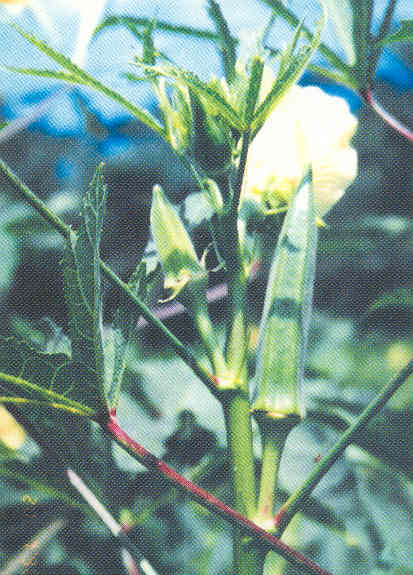PENANAMAN BENDI
1. Nama Tempatan: Bendi, Okra (Hibiscus esculentus)

|
2. Pendahuluan:
| |
Bendi yang dipercayai berasal dari Afrika Utara ialah sejenis tanaman sayuran buah yang berlendir. Ia mudah ditanam dan kurang diserang penyakit dan perosak. Buah dan bahagian-bahagian lain tanaman ini boleh dipelbagai gunakan seperti buahnya boleh dimasak dengan pelbagai cara; kari, sebagai ulam, salad dan digoreng. Buahnya juga diproses iaitu ditin, dibekukan dan dijeruk dengan garam. Lendirnya pula digunakan sebagai bahan pemekat untuk sos tomato. Di India, batang-batang bendi yang tua dijadikan kertas dan biji-bijinya yang tua dijadikan minuman harian menggantikan kopi.
|
3. Tanah:
|
|
Bendi boleh ditanam di kebanyakan jenis tanah seperti gembur berpasir, tanah liat, tanah gambut dan tanah-tanah lembah sungai yang bersaliran baik.
|
| |
A. Menyedia Kawasan |
Bajak dan gemburkan tanah sedalam 15 - 22 sm. Buat pengapuran jika perlu iaitu 2 minggu sebelum menanam. Sediakan batas. Gaulkan ke dalam tanah, baja organik seperti tahi ayam reput sebanyak 3 hingga 5 tan sehektar.
|
| |
B. Menanam |
Tanam biji benih sedalam 2.5sm di batas. Pastikan dibubuh 2 biji selubang. Jarak tanaman yang disyorkan ialah 90 sm antara pokok. Selepas 2 minggu, cabut satu pokok yang kurang subur. Sebanyak 11 gm biji benih diperlukan untuk satu batas yang berukuran 1.2 m lebar dan 30 m panjang.

|
| |
C. Membaja |
Tabur baja sebatian NPK Blue Special (12:12:17:2) di keliling pokok setiap 2 minggu. Untuk sehektar memerlukan 1 tan baja.
|
| |
D. Menyiram |
Siram sekali sehari pada waktu petang. Penyiraman penting di peringkat pokok mengeluarkan bunga dan pembentukan buah.
|
| |
E. Merumput |
Cabut rumpai jika perlu atau gunakan racun herba. Ikut arahan pada label racun herba tersebut.
|
| |
F. Sungkupan |
Buat sungkupan daripada jerami padi, daun-daun kering atau kepingan plastik hitam bagi mengawal rumpai dan untuk mengekalkan kelembapan.
|
| |
G. Memangkas |
Setelah semua hasil dipetik, pokok-pokok perlu dipangkas setinggi 40 sm hingga 60 sm dari paras tanah untuk mendapatkan hasil bagi kali kedua. Empat hingga lima tunas baru dibiarkan membesar selepas pemangkasan. Pemangkasan ini diikuti dengan pembajaan.
|
4. Kawalan Musuh Dan Penyakit:
| |
Musuh utama tanaman bendi ialah serangga dan perosak seperti ulat pengorek dan kepinding buah yang merosakkan buah-buah bendi pada semua peringkat pertumbuhan buah. Sekiranya serangan teruk, gunakan racun serangga seperti Diazinon.
Penyakit utama tanaman bendi ialah bintik daun yang terdapat pada daun-daun tua di mana daun-daun ini kelihatan bertompok-tompok hitam dan berjelaga. Penyakit ini boleh dikawal dengan menyembur racun kulat Benomyl. Penggunaan racun-racun hendaklah mengikut arahan label.
|
5. Penuaian:
| |
Buah-buah bendi boleh dituai dengan memotong 2 sm dari pangkal buah. Elakkan dari tercedera kerana lendirnya akan keluar berterusan dan ini boleh menjatuhkan mutu buah. Penuaian mula dilakukan ketika:
i. 50 - 55 hari selepas menanam.
ii. 5 - 6 hari selepas bunga berkembang dan berlaku pendebugaan.
iii.Buah berukuran 10 - 12 sm panjang, iaitu buah-buahan masih lembut, hujungnya rapuh, senang dipatahkan dan belum berpulur.
Pada peringkat ini buah-buah telah mencapai kadar pertumbuhan yang paling tinggi dan hendaklah dituai supaya pokok-pokok bendi boleh terus mengeluarkan bunga-bunga baru dan seterusnya menjamin pengeluaran buah yang berterusan. Hasil dikutip setiap 2 hari sekali dan berterusan sehingga 8 minggu. Jumlah hasil dianggarkan 10,000 - 15,000 kg sehektar.
|
6. Pengendalian Lepas Tuai
| |
Buah-buah yang telah dituai dikumpulkan di tempat teduh dan dimasukkan ke dalam bakul (plastik atau buluh) yang telah dialas dengan kertas atau plastik cerah yang berlubang. Ia hanya boleh disimpan selama 2 - 3 hari sahaja tanpa dibungkus dengan plastik. Sedikit air perlu dipercikkan supaya pengudaraan menjadi lembab. Buah-buah yang dibungkus dengan beg plastik boleh disimpan selama 7 - 8 hari dalam keadaan suhu 24 darjah Celcius - 26 darjah Celcius dan kelembapan bandingan 70 - 75 %.
|
| Atas |
|
| |
| Sumber: Panduan Menanam Bendi, Jabatan Pertanian Semenanjung Malaysia. |

